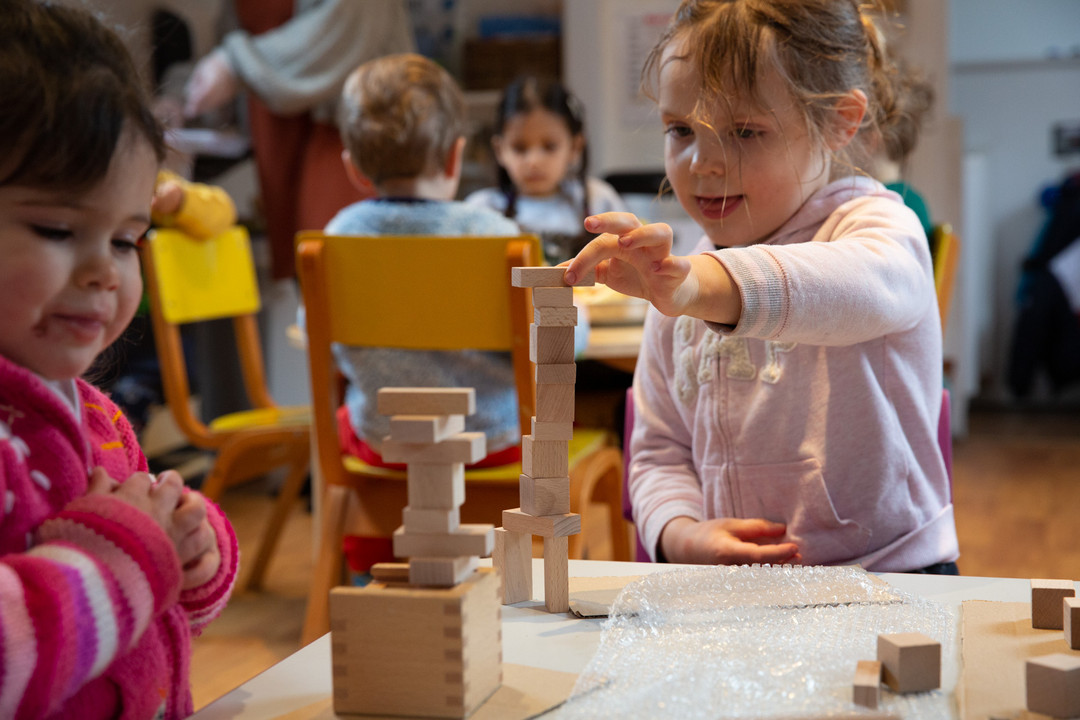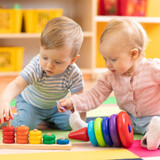Froebel Gifts: An Introduction
You may have heard of Fröebel Gifts (we carry the full selection here), but you may also wonder what they are.
In a nutshell, Fröebel Gifts (“Gabe” in German) are educational materials designed by Friedrich Fröebel in the 1840s to support learning and development in his kindergarten in Germany. The Gifts allow for open-ended, creative play as well as providing an introduction to concepts of math, science, engineering, and architecture.
Fröebel’s kindergartens became popular in Germany but were banned in 1851 by the Prussian government following a series of general protests and rebellions. The regime cracked down on ideas considered socialistic and revolutionary and Fröebel’s concepts fell into that category. Many who taught at Fröebel’s kindergartens left Germany and spread his teaching method around the world. Fröebel’s principles were among the ideas that influenced Maria Montessori’s theories and teaching methods.
Originally, Fröebel designed 6 Gifts which would be introduced in sequence, starting with simple lessons and building up to more complex ones. After his death in 1852, his devotees developed more Gifts so there are 14 in use today.
WHY ARE THEY CALLED GIFTS?
Fröebel referred to these materials as “gifts” because:
(a) they were given to each child
(b) they were tools to observe the child’s innate “gifts” with which they were born
The Gifts consist of objects, such as cubes, spheres, cylinders, prisms and sticks, that represent common patterns and forms found in nature. Each Gift relates to the others in some way. The Gifts are divided into different forms:
- Gifts 1-6: solids
- Gift 7: surfaces
- Gift 8: lines
- Gift 9: rings
- Gift 10: points
There are 4 additional gifts: 5B, 5P, J1 and J2 that feature circles, beads, pegs and/or laces.
Fröebel believed that firsthand experiences are crucial to development and that struggle, discovery and repetition are key elements in learning. He recognized that children like to take things apart, experiment with the pieces and put them together. Each Gift is always presented as a whole form and must be put away as a whole form. There are 2 basic “rules” for play:
- Every piece must be used
- Changes cannot be made by destroying and rebuilding. Changes may only be made by modifying
Some Gifts are hard, some are soft. Some can be rolled, others have flat sides. Children play freely with the Gifts and discover similarities and differences between the pieces, while also finding connections to the world around them.
Parents and teachers also play a role in Fröebel’s methods, introducing the language of shape and form, similarity and difference, math, architecture, storytelling, etc.
THE GIFTS
Gift 1 consists of 12 knitted balls in 6 primary and secondary colours in a wooden slide-top box. Half of the balls have a loop attached and half do not.
The balls are used to explore colour, sorting and movement (rolling, swinging, bouncing, etc), as well as imaginative play.
Gift 2: Cube, Sphere & Cylinder
Gift 2 consists of a wood stand and frame with 2 each of 3 basic geometric forms (cube, sphere and cylinder) plus 2 sticks (one short and one long). One of each of the forms is solid while the other has holes drilled through for spinning them on the sticks. The drilled blocks also have metal loops so that they can hang on the frame.
These forms are used to compare the shapes, as well as to explore movement and observe patterns created by spinning the blocks. Children can also investigate the idea of resonance by tapping the pieces together or on a table.
Gift 3 consists of 8 x 2.5-cm wooden cubes that can be assembled into a single 5-cm cube or a variety of other forms and structures (particularly when used together with other Fröebel sets).
This Gift is used for sorting, differentiation and counting, as well as introducing the language of arithmetic (addition, subtraction, multiplication, division) and fractions (parts of a whole).
In Gift 4, the cube from Gift 3 is divided into 8 oblong blocks measuring 5 cm x 2.5 cm x 1.25 cm, which can be assembled into a cube or a variety of other forms.
This Gift is used to introduce the concepts of fractions and proportions in the way that the dimensions of the blocks relate to each other and to expand vocabulary to include height, length, width, etc.
Gift 5: Cubes & Triangular Prisms
Gift 5 consists of cubes and triangular prisms (39 pieces in all), representing a larger 7.5-cm cube. It incorporates more pieces and an assortment of shapes.
The pieces can be assembled into a variety of forms to explore concepts of geometry, symmetry, proportion and dimension. The introduction of the triangle opens up more possibilities to explore. For older children, this Gift can be used to represent more abstract math concepts, such as the Pythagorean Theorem.
Gift 6 consists of a variety of 32 prisms, including oblong blocks, flat square blocks (caps), and narrow columns. This set introduces new proportions of the cube introduced in Gift 5.
The pieces can be assembled into a number of forms and structures and are intended to encourage free play and exploration. The inclusion of the cap and column introduces elements of architecture. For example, Frank Lloyd Wright’s Larkin Building in Buffalo, NY can be represented using the contents.
Gift 7 consists of small wood tiles in 8 shapes, including squares, circles, half-circles, and equilateral, isosceles and scalene triangles, and in 8 colours. The shapes are derived from the surfaces of the first six Gifts and introduce the concept of surface or plane as a separate object. Where Gifts 1-6 allowed the creation of 3D objects, Gift 7 represents these objects in 2D form.
The pieces can be used to create diverse parquet and mosaic-style designs or for sorting and counting exercises. This Gift also introduces geometry and the shapes can be combined to form various geometric shapes, including pentagon, hexagon, octagon, trapezoid, rhombus, and more.
Gift 8 consists of thin wooden sticks in a variety of colours and 6 lengths ranging from 2.5 cm to 15 cm (about 1" to 6"). The sticks move from the exploration of surfaces introduced in Gift 7 to the exploration of edges and outlines of objects.
The sticks can be arranged to create countless objects and abstract patterns, and are also useful for demonstrating arithmetic functions (addition, subtraction, multiplication, division, greater than/less than, etc.)
Gift 9 consists of thin wooden rings and semi-circles, each in 3 different sizes and a variety of colours. The rings introduce the concept of the circle and curved lines. Gifts 8 and 9 are often used together.
The rings introduce the ideas of whole/half, diameter/circumference, inside/outside, and the concept of curve direction (or orientation). The pieces in this Gift (as in all the Gifts) offer opportunities for representing objects in the child’s life and for imaginative play.
Gift 10 consists of small wood discs, 60 of each in 8 different colours. This Gift builds on lessons learned from previous Gifts, which started with solid forms (Gifts 1-6), then surfaces (Gift 7), and finally lines (Gifts 8-9). Gift 10 introduces a higher level of abstraction, where children learn to use points of intersection.
This Gift is used to explore mathematics and the idea of position and connecting points to form a line. Concepts of geometry can be explained by adding a grid on which the child can place the discs at the intersections to form lines (horizontal, vertical, or diagonal) and shapes (circle, triangle, square, etc), as well as freestyle designs.
Gift 5B - Semi-Circles & Triangular Prisms
Gift 5B includes a collection of cubes, triangular prisms, half-cylinders and curved blocks, 44 pieces in all. A variation on Gift 5, this set introduces half-cylinders and matching concave parts.
The pieces can be assembled together into a variety of forms and structures, encouraging free play and exploration. The set also helps to further develop mathematical skills, including sorting, counting, arithmetic, and a basic understanding of fractions. It can also represent more abstract mathematical concepts, such as the Pythagorean Theorem.
Gift 5P - The Curvilinear Gift
Gift 5P consists of 3 divided concentric circles (36 pieces in all) plus 9 numbered wooden cubes. This set is a variation on Gift 5 and is a more complicated segmentation suitable for older children.
The pieces can be assembled into many forms, particularly when used together with other Fröebel sets, and are especially suited to architectural constructions. Concepts of ring, disc, arc, diameter, radius and concentric are also introduced, as well as the idea of “curving over” and “curving under”.
Gift J1 consists of chunky wooden beads in 4 shapes - spheres, cubes, cylinders, and triangular prisms - and a variety of colours.
This Gift includes a length of cord that can be used to string the bead together and is useful for sorting and counting exercises.
Gift J2 consists of small wood pegs with colour-matched cords in 8 different colours, along with a square pegboard.
The pieces can be used to create a wide variety of patterns and shapes while developing fine motor skills and are useful for sorting and counting exercises.
FRÖEBEL’S LEGACY
While Friedrich Fröebel’s ideas were considered revolutionary in the 1850s, the principles he developed influenced early childhood education around the world. In the 25 years following his death in 1852, kindergartens were established in leading cities around the world, including Canada. His ideas also influenced other educational pioneers, such as Maria Montessori, and modern approaches to early childhood education are rooted in his principles.
Thinkamajigs offers a wide variety of Montessori and Montessori-inspired teaching materials, educational toys, games, and related products, and we are constantly adding new items from around the world. While each product's educational benefits and merits are first and foremost, we also ensure that every item meets our high standards of quality, durability, safety, and value, so you can be confident you’re buying a great product at a great price with great customer service.
Please visit ourwebsite, call us at 800-363-3013, or contact us here.
LATEST BLOG POSTS
How To Set Up A Montessori Environment At Home
Creating a Montessori-inspired environment at home provides the opportunity to support your child's...
Montessori & Technology: do they play well together?
Dr. Maria Montessori’s method of teaching children emphasizes the use of concrete materials and hand...
Froebel Gifts: An Introduction
You may have heard of Fröebel Gifts (we carry the full selection here), but you may also wonder what...
Safe Toys for Toddlers: What Parents Should Know
As a parent, you want to be sure that any toys your toddler plays with are safe and age-appropriate....
Infant & Toddler Toy Guide - Part 2
THINKAMAJIGS’ GUIDE TO CHOOSING EDUCATIONAL TOYS FROM BIRTH TO AGE 3PART 2: AGE-RELATED DEVELOPMENTA...
Infant & Toddler Toy Guide - Part 1
THINKAMAJIGS’ GUIDE TO CHOOSING EDUCATIONAL TOYS FROM BIRTH TO AGE 3PART 1: SKILLS DEVELOPMENT“What...







